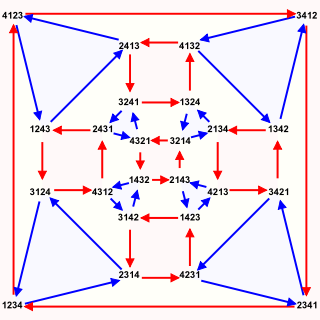
In abstract algebra, the symmetric group defined over any set is the group whose elements are all the bijections from the set to itself, and whose group operation is the composition of functions. In particular, the finite symmetric group defined over a finite set of symbols consists of the permutations that can be performed on the symbols. Since there are such permutation operations, the order of the symmetric group is .

In the area of abstract algebra known as group theory, the monster group M (also known as the Fischer–Griess monster, or the friendly giant) is the largest sporadic simple group, having order
808,017,424,794,512,875,886,459,904,961,710,757,005,754,368,000,000,000
= 246 · 320 · 59 · 76 · 112 · 133 · 17 · 19 · 23 · 29 · 31 · 41 · 47 · 59 · 71
≈ 8×1053.

In the area of modern algebra known as group theory, the Conway groups are the three sporadic simple groups Co1, Co2 and Co3 along with the related finite group Co0 introduced by (Conway 1968, 1969).
In mathematics, a Ree group is a group of Lie type over a finite field constructed by Ree from an exceptional automorphism of a Dynkin diagram that reverses the direction of the multiple bonds, generalizing the Suzuki groups found by Suzuki using a different method. They were the last of the infinite families of finite simple groups to be discovered.






